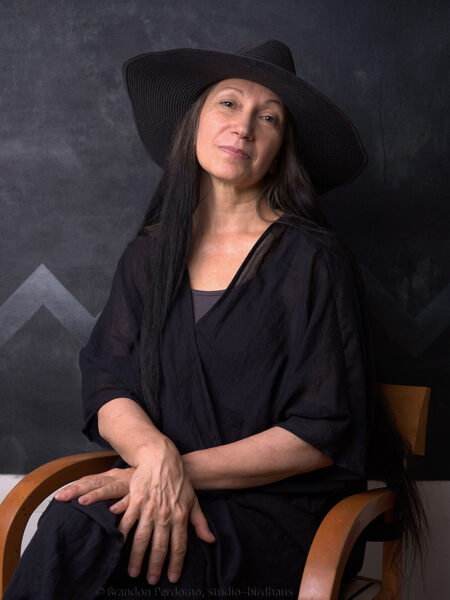Tatawaw.
If you haven’t done so already,
please start by visiting the entry page here.
bio
Bebonkwe Brown ᐱᐳᐣ ᐅᓵᐃ is a contemporary Plains Cree/Anishnawbe/Metis Nation artist from
Paspaschase First Nation, Alberta, Canada. Her home territory is in and around Amiskwacîwâskahikan
(aka Edmonton). Throughout her career she has made camp at various locations in Canada, the USA and the UK, including Vancouver, Toronto, Winnipeg, the Lower Similkameen Reservation (Keremeos, BC), St.Paul (Minnesota), Brighton (UK) and London (UK). She has been based in Brooklyn, New York since 2006.
Bebonkwe studied fine arts in London (UK) and Toronto (Canada), as well as apprenticing in traditional First Nations art forms and cultural/ceremonial practices with highly respected artists, elders and medicine people. She has received project awards from the Canada Council for the Arts, the Ontario Arts Council, the Alberta Foundation for the Arts, First Peoples Fund and the Foundation for Contemporary Arts. She is a recipient of the prestigious Chalmer’s Arts Fellowship and has participated in a number of reputed artist residencies. She has also been a provincial and federal level arts funding juror, and worked in First Nations Cultural advisory and educational roles for art institiutions and exhibitions. Her work has been exhibited, screened, and performed internationally.
Bebonkwe’s trailblazing 38 year practice employs and entwines the creative genres, iconography, technology, and languages of both Indigenous and Western creative traditions and genres, always maintaining a foundation of ancient First Nations paradigm, perspective, and connection, while pushing the boundaries of Contemporary Western arts practices. Numerous signature elements of her practice have now been adopted or appropriated and remixed by contemporary Native and Eco arts peers, some now becoming common practices within these milieus.
Bebonkwe (Beh-bone-kway) means Winter in Anishnawbe
Winter ᐱᐳᐣ is Pipon (Pih-poun) in Plains Cree.
Though her strongest cultural affiliation is Plains Cree, the artist usually uses Bebonkwe
to honor the Anishnawbe ceremony and elder she received her named in and from,
along with Anishnawbe teachings.
Bebonkwe Brown is also known as Jude Norris, Kihiw Mitahtahkwan Awasis & sometimes, Nia Lova.
instagram @bebonkwe
artist statement
I’m deeply invested in and excited by making contemporary artwork that continues vibrant, sophisticated, community-centered and ever-evolving First Nations creative legacies.
Since 1986 I’ve created a large body of multimedia work using my English/Metis name, Jude Norris.
The body of work I’ve created since 2012, when I refocussed on my original medium, painting,
along with continued and new sculpture series work,
has been created as Bebonkwe Brown, a combination of my Native name
and my Russian grandfather’s immigrant alias.
My names, practice and materials reflect the challenge, strangeness and constant dichotomies I experience as a First Nations woman navigating deep cultural polarities and damage within colonized Indigenous territories, and a commitment and ability to find, maintain, and/or create culturally-informed continuance and poetry within these environments. I survey and re/contextualize dysfunctional and traumatizing colonial/colonized mind-frames and modes of operating, creatively intervening with, disrupting, unsettling and transforming them. I work in a variety of media, combining traditional Indigenous science with Western new-tech, organic with digital, to create work that reflects this journey in a way that’s highly contemporary yet informed by and infused with ancient First Nations cultural teachings, paradigms, experience and aesthetic.
My paintings, drawings and sculptural works involve collaborations with culturally relevant animals and plants, and/or contain organic, industrially made and ‘urban’ materials and imagery, often considered refuse, gathered from the land by hand or with my camera. I use the same culturally informed approach and process with all my materials, with the awareness that they are all gifts from the Earth and/or my Ancestors.
My work houses paradox in both energy and aesthetic, often juxtaposing dispirit materials, genres, paradigms, technologies, and/or imagery; serenity/ferocity, balance/tension, recognizable/unknowable, comforting/uncanny, damage/healing, grief/joy, Indigenous/Settler, reverent/playful, physical/spiritual, linear/circular, expressionistic/geometric, aqueous/earthy, etc. At the heart of all this is a deep awareness of and concern with the need to re/balance feminine and masculine energies.
The repurposing and repositioning of the Western in artworks centering and continuing long-standing matriarchal First Nations perspective, knowledge, history, technology, and creative practices is a main vien running through all my work. It is equally present in my paintings and drawings. They involve a reclamation of Plains Nations women’s unfathomably long history of creating sophisticated abstraction, and the deep but largely unacknowledged influence of this history on male-dominated Settler abstract art genres purported to be ‘new’. Within this I also explore, implement and extend pan-tribal adornment, using the same kind of visual and material combinations present throughout my practice, and disregarding Western compartmentalizing of painting and sculpture.
The fem-centric aspects of my practice conjunctively embrace the transformational potential of artful acts, images, objects and/or projects that exteriorize spiritually/culturally connected listening, seeing and creativity. My abundance of water and washes of color, cathartic gestural lines, and the recurring tribal geometries that continue spiritually invoked Plains/Cree mark-making and adornment traditions are all examples of this. These and other elements and layers within my artworks contain metaphoric and literal transmutation of the seemingly insurmountable into actions and artworks embodying resilience, lyricism and good medicine.

Bebonkwe with ‘pehpehtahkwiik 2.
Photo by Brandon Perdomo 2022.